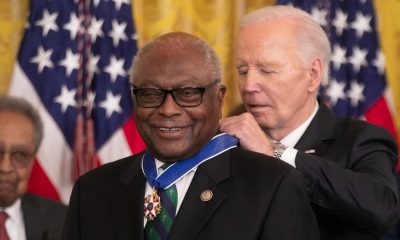National
Supreme Court to Hear Voting Rights Act Challenge

 National Black Chamber of Commerce Opposes Law
National Black Chamber of Commerce Opposes Law
By George E. Curry
NNPA Editor-in-Chief
WASHINGTON (NNAP) – After hearing oral arguments earlier on whether an affirmative action program at the University of Texas is constitutional, the United States Supreme Court has agreed to review a challenge to the Voting Rights Act of 1965, paving the way for the court to rule on two major civil rights issues by next summer.
The court agreed last Friday to hear a case from Shelby County, Ala., 23 miles southeast of Birmingham, that questions whether Congress exceeded its authority when it voted in 2006 to renew Section 5 of the Voting Rights Act, which requires jurisdictions covered by the legislation to pre-clear any election law changes with the U.S. Attorney General or the U.S. District Court in Washington, D.C. to prevent discriminatory voting changes from going into effect.
Oral arguments in the voting case are expected to be held in February with rulings in both the voting rights and affirmative cases likely to be announced next summer, probably in July. Two lower courts upheld the constitutionality of the Voting Rights Act extension before the Supreme Court decided to accept the case for review.
The Voting Rights Act was originally passed in 1965 on the heels of the Selma-to-Montgomery (Alabama) March. When Section 5 was scheduled to expire, it was extended by Congress in 1970, 1975, 1982 and for another 25 years in 2006. It was approved the last time with broad bipartisan support. It passed the House by a 390-33 margin and the Senate 98-0. George W. Bush signed the extension in a Rose Garden ceremony attended by members of the Congressional Black Caucus.
In its petition, Shelby County, the fastest growing county in Alabama, argued that the pre-clearance provision of Section 5 of the Voting Rights Act violates the Tenth Amendment and Article IV of the United States Constitution. Both provisions grant states power to regulate its elections. In passing the law, Congress relied on the Fifteenth Amendment which prohibits states from denying a citizen the right to vote based on race, color, or previous condition of servitude such as slavery.
Shelby County went to court after the Justice Department rejected a redistricting plan that apparently played a role in the defeat of Ernest Montgomery, the only Black member of the 5-member city council in Calera, Ala., a bedroom community of 12,000 people.
Montgomery was elected to the council in 2004 from a district that was nearly 71 percent Black. The district was redrawn two years later, reducing the Black presence to 23 percent. Montgomery narrowly lost his 2008 re-election bid to a White challenger. But the Justice Department invalidated the election because district changes had not been pre-cleared. Shelby County went to court to overturn the decision.
The 1965 Voting Rights Act created federal oversight of elections in Alabama and other states and jurisdictions with a history of discriminatory voting practices.
“Things have changed in the South,” the Shelby County petition argued. “Voter turnout and registration rate now approach parity. Blatantly discriminatory evasions of federal decrees are rare. And minority candidates hold office at unprecedented levels.” The county charged that the federal government is still relying on data more than 35 years old and “it fails to account for current political conditions.”
Attorney generals in six states covered by Section 5 – Alabama, Arizona, Georgia, South Carolina, South Dakota and Texas – filed a joint brief in support of Shelby County.
Surprisingly, the National Black Chamber of Commerce, which describes itself as “a nonprofit, nonpartisan organization dedicated to the economic empowerment of African American communities through entrepreneurship,” filed a friend-of-the-court brief supporting Shelby County’s position opposing continued federal oversight under the Voting Rights Act.
By taking that position, the Black business group headed by Harry C. Alford aligned itself with right-wing anti-affirmative action groups such as the Mountain States Legal Foundation and the Pacific Legal Foundation. Both groups filed friend-of-the-court briefs with the Supreme Court opposing affirmative action in the University of Texas case and petitions supporting the stance of Shelby County, Ala.
“…Section 5 is no longer necessary to combat widespread and persistent discrimination in voting and now, perversely, serves as an impediment to racial neutrality in voting and to the empowerment of state and local officials who represent minority constituencies,” the National Black Chamber of Commerce said in its brief. “The Chamber rejects the assumption underlying Congress’s reauthorization of Section 5 of the Voting Rights Act that the exceptional circumstances which justified close federal oversight of the electoral practices of many states and localities in 1965 and 1975 persist today. They do not.”
The United States Justice Department responded to the challenge to the law by reciting the long history of Black voter disenfranchisement.
“Although the Fourteenth and Fifteenth Amendments have since 1870 guaranteed United States citizens’ right to vote free of discrimination on the basis of race, ‘the blight of racial discrimination in voting…infected the electoral process in parts of our country for nearly a century,’” the U.S. brief stated, quoting a 1966 Supreme Court decision involving South Carolina. “Beginning in 1890, some States – located mostly in the South – undertook a systematic campaign to disenfranchise minority voters. After many decades of inaction, Congress eventually responded, first by enacting the Civil Rights Act of 1957, which authorized the Attorney General to seek injunctions against public and private interference with voting on racial grounds.”
It added, “When that measure proved insufficient, Congress enacted the Civil Rights Act of 1960, which expanded the Attorney General’s litigation power by authorizing him to join States as party defendants, giving him access to local voting records, and empowering courts to register voters in areas where there had been systematic discrimination.
“That legislative response also proved insufficient, prompting Congress to enact Title I of the Civil Rights Act of 1964, which provided for expedited treatment of voting cases before three-judge courts and made illegal some of the tactics that had been used to disenfranchise African-Americans in federal courts.”
Still, the Justice Department said, “…each measure ‘proved ineffective for a number of reasons.’” Consequently, another approach was finally adopted.
“Faced with the fact that a serious and invidiously discriminatory obstacle to the proper functioning of our democracy had proven nearly impervious to traditional legislative remedies, Congress enacted more aggressive and unusual measures as part of the Voting Rights Act of 1965,” the federal brief stated.
Chief among the new measures was the pre-clearance provision that applies to eight states: Alabama, Alaska, Arizona, Georgia, Louisiana, Mississippi, South Carolina and Texas. It also applies to certain counties in Virginia, Florida, North Carolina, New York, California and South Dakota as well as specific townships in Michigan and New Hampshire.
Section 5 contains a “bail out” component that allows jurisdictions to avoid the pre-clearance requirement if they can demonstrate they have complied with specified non-discrimination requirements for 10 years. Forty-six jurisdictions have successfully bailed out of the pre-clearance requirement and two cases are pending.
Before reauthorizing the Voting Rights Act extension in 2006, Congress considered the arguments later advanced by Shelby County, Ala. and the National Black Chamber of Commerce that there is no need for continued federal oversight of select jurisdictions.
In its brief, the Justice Department quoted findings by Congress that showed while blatant voter discrimination had been reduced over the past four decades, largely because of the Voting Rights Act, “vestiges of discrimination in voting continue to exist as demonstrated by second-generation barriers constructed to prevent minority voters from fully participating in the electoral process.”
The Justice Department noted that, “Congress had found ample evidence of a history and ongoing pattern of purposeful, state-sponsored voting discrimination in covered jurisdictions.”
For example:
• In Kilmichael, Miss., the all-White governing body tried to cancel an election after Blacks became a majority in the city;
• Congress found that the school board in Webster County, Ga. sought to “intentionally decrease the opportunity of minority voters to participate in the electoral process” after a majority Black school board was elected; and
• A three-judge court found that Texas engaged in intentional discrimination against its Black and Latino citizens in the redrawing of boundaries for congressional and state Senate districts. The court found the congressional districts were redrawn to remove the home office of numerous minority legislators from their districts without doing the same to any White officeholders. The court ruled in Arlington Heights v. Metropolitan Housing Development Corp. that the action was “unexplainable on grounds other than race.”
In its joint friend-of-the-court brief, four civil rights groups – the NAACP Legal Defense and Educational Fund, the Lawyers Committee for Civil Rights Under Law, the American Civil Liberties Union (ACLU) and the NAACP – rebutted the assertion that things have improved to the point that Section 5 is no longer needed.
Since 1982, there were approximately 800 court rulings that were favorable to voters of color, according to the groups’ petition. “Of these, approximately 81 percent were brought against Section 5 covered jurisdictions.”
###







































